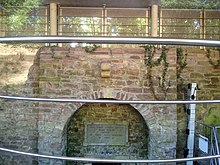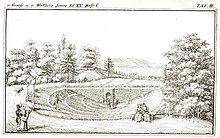Vapor cave
The vapor cave in Bad Pyrmont is a brick grotto from which carbon dioxide flows. After the Dog's Grotto near Naples was walled up after the Second World War , it is the only cave of its kind in Europe .
Geographical location
The vapor cave is located in a valley about one kilometer (10 minutes' walk) from the city center. It is located about 100 meters north of "Sauerbrunnen III" and northeast of "Brodelbrunnen" in a funnel-shaped depression, a former quarry that was built in the 17th century on the slope of the bomber. The property with the vapor cave is bordered by the streets “Am Helvetiushügel” and “An der Dunsthöhle”.
geology
The floor of the valley is made of red sandstone . The edges surrounding the valley consist of Keuper on the outside and shell limestone on the inside . The valley was formed either by an earthquake or a volcanic eruption, in which the volcanic masses did not penetrate to the surface. During this event, the red sandstone was lifted and the Keuper and Muschelkalk strata, which lay one on top of the other in the natural sequence, were pushed outwards. The fact that all the sand and limestone layers at the edge of the boiler are upside down speaks for a volcanic event . This reverse stratification suggests that the bottom of the valley was raised in the shape of a bubble. After the rock bubble burst, the edges remained crater-shaped. In the middle of the boiler is the channel from which the explosion originated.
Gas exhalation
In total there are three mofettes in the valley , of which the source of the vapor cave is the most productive. It is one of the cold iron sourlings. As there is no water in the superficial rock layers with which the CO 2 can combine to form carbonic acid , the gas can develop freely and flow out of the ground. These gases are therefore considered to be dry gas exhalations . Considerable amounts of CO 2 escape from the soil . Because the gas is heavier than normal air, a layer of carbon dioxide a few inches to two feet high forms above the ground . How high the layer is depends primarily on how easily the CO 2 flowing out can mix with the atmosphere. In persistently dry weather and with low air pressure, the CO 2 outflow is much stronger than with high air pressure or after heavy rainfall. Since the gas source is provided with source enclosures and conversions, the gas also rises significantly higher under favorable conditions. As a result, it can rise to a height of 2.40 meters and higher. The average concentration of CO 2 in the gas layer is 13.5 percent. The temperature of the gas is at an air temperature of 31 ° C at 16 ° C. At an air temperature of −1.2 ° C, the gas temperature is 2.1 ° C.
discovery
In the early 18th century, workers noticed that a gas was leaking from the rock in the quarry. If they got near the gas leakage, they passed out after a while. During heavy rain, the carbon dioxide rose from the rainwater in the form of bubbles. Dead birds and other dead animals were often found near the gas wells. In 1712 the well doctor Johann Philipp Seip came to Pyrmont and investigated this natural phenomenon. Due to the asphyxiating properties of the gas, Seip initially assumed that the gas was sulfur gas .
Construction of the grotto
In 1720 Seip, who was the first to recognize the healing effects of the escaping gas, had the grotto expanded in order to make it accessible to the public as a “dry sweat bath”. Since Seip initially assumed that the gas was sulfur , he named the cave Sulfur Cave . When he later discovered that there was not the slightest trace of sulfur in the escaping gas, he renamed the sulfur cave the vapor cave . In 1737 he had the cave renovated and several Latin inscriptions attached to the outer wall. The following inscription is on a plaque:
" Do you make Italy big with rarities,
look here, the sulfur pit also steams from Pirmont's lap "
In 1810 the vapor cave was rebuilt again and received its final shape. An amphitheatrical terrace was built in front of its entrance . For this purpose, the soil was dug in steps and lawns grew on the steps. In 1833 the gas bath was renewed based on suggestions from Carl Ferdinand Graefe. In 2000 the building above the cave was renewed as part of the “Aqua Bad Pyrmont” EXPO project . In addition, the surrounding park was redesigned and the keeper's house in front of the entrance to the cave was renewed.
use
After Seip had a vault built over the Mofette , he began to treat the sick with the gas escapes. However, these therapies could not be carried out continuously. The reason for this was the changing level of carbon dioxide and the difficulty in locking the mofette. Depending on the height of the gas layer, the sick were placed on the appropriate terrace steps. After Seip did not continue his therapies, the facility was visited by sufferers from the area. The doctor Georg Theodor Valentiner also carried out healing experiments on patients in the cave and described the negative effects of carbon dioxide on people. When visiting the cave, the sick got headaches and, depending on their physical condition, they got dizzy. In addition to this therapeutic use, the cave was also used for other experiments. The doctor Henrich Matthias Marcard examined the effect of carbon dioxide on fresh meat, and found that the meat did not rot even after nine days of storage in the cave, but had only changed to the extent that it had acquired a sour smell. Another experiment was the distribution of soap bubbles over the CO 2 hood. Since the air in the soap bubbles is lighter than the carbon dioxide, the soap bubbles do not sink to the ground. This marks the height of the carbon dioxide layer. Another experiment was putting a burning object into the CO 2 , which would extinguish the flame after immersion. Johann Wolfgang von Goethe was very impressed during his visit to the vapor cave and described the experiments in his annals . Goethe also carried out several experiments himself, including the experiments with soap bubbles and with a burning straw. Goethe filled the CO 2 in Pyrmont bottles and took them with him to Weimar . There he conducted experiments with a burning wax stick in front of an assembled company.
Today is carbon dioxide source gas therapy for the following indications offered: disorders of peripheral blood circulation , hypertension and coronary insufficiency , allergic diseases ( asthma , eczema ); poorly healing wounds .
Web links
Individual evidence
- ↑ a b c d Rudolph Ludwig: The common salt and iron sourlings to Pyrmont. Publishing house of the court bookstore by G. Jenghaus, Darmstadt 1862
- ↑ Christa-Vera Grewe: Investigation of the scientific fragments of the Stoic philosopher Poseidonios and their significance for his natural philosophy. Approved dissertation at the University of Hanover, Hanover 2005, p. 165, online (accessed on August 17, 2018).
- ↑ a b c d e f g h Bad Pyrmont (Hrsg.): Natural phenomenon vapor cave. Information sheet on the vapor cave
- ↑ a b c d e f Theodor Valentiner: Pyrmont for spa guests and foreigners. Published by Carl Schröder & Comp., Kiel 1959
- ↑ Josef Seegen: Handbook of the general and special doctrine of healing springs. Second revised edition, KK court bookseller Wilhelm Braumüller, Vienna 1862.
- ↑ a b J. Boegner: The origin of the springs and the formation of the mineral springs. Printed and published by Heinrich Ludwig Brönner, Frankfurt AM 1843
- ↑ a b c d e f Carl Ferd. v. Graefe: The gas sources in southern Italy and Germany. Printed and published by G. Reimer, Berlin 1842.
- ↑ a b c Josef Seegen: Compendium of the general and special healing spring theory. First division, KK court bookseller Wilhelm Braumüller, Vienna 1857.
- ↑ DWH Busch, JF Dieffenbach, JFC Hecker, E. Horn, JC Jüngken, HF Link, J. Müller (Eds.): Encyclopedic Dictionary of Medical Sciences. Twenty-eighth volume, published by Veit et Comp., Berlin 1842.
- ↑ B. Studer: Textbook of physical geography and geology. Second chapter, published by JFJ Dalp, Berlin Chur and Leipzig 1847.
- ↑ a b Die Dunsthöhle (badpyrmont.de) (accessed on August 13, 2018)
- ↑ Princely Waldeck'scher fountain doctor in Pyrmont, Friedrich Steinmetz The vapor cave in Pyrmont, with reference to the Grotta del cane and Pyrmont's new gas bath , Journal der Chirurgie und Augen-Heilkunde, XX (1833), pp. 52–80, with 2 plates.
- ^ The vapor cave on Helvetiushügel (accessed on May 30, 2012).
- ^ Henrich Matthias Marcard: Description of Pyrmont. First volume, by Weidmanns Erben and Reich, Leipzig 1784.
- ↑ Liselotte Folkerts: Goethe in Westphalia, no love at first sight. LIT Verlag Dr. W. Hopf Berlin 2010, ISBN 978-3-643-10938-5 .
- ↑ The vapor cave - a unique natural phenomenon. (accessed on July 9, 2012).
- ^ Statement by the state baths Pyrmont on its website , accessed on May 30, 2012.
Coordinates: 51 ° 59 ′ 19.9 " N , 9 ° 15 ′ 38.7" E


